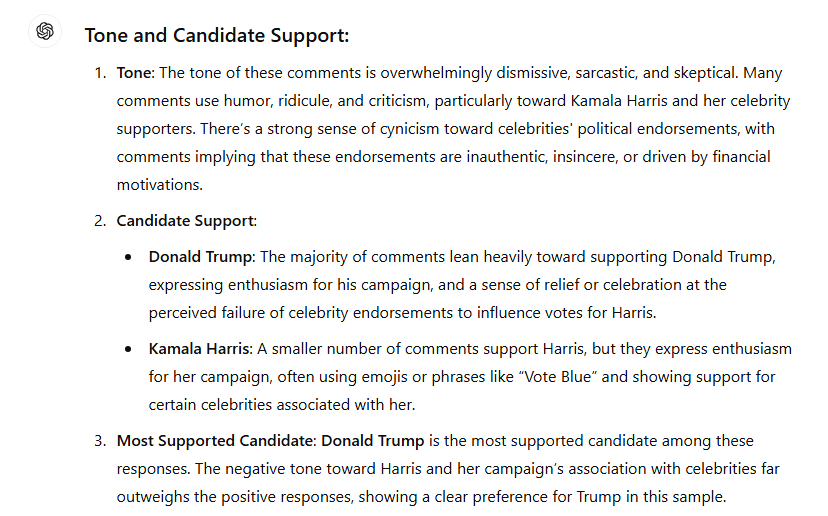Veille réputation
Protégez votre image de marque.
Retour
Solutions
Réputation
Veille réputation
Protégez votre image de marque.
Communication de crise
Anticipez les bad buzz.
Leader advocacy
Boostez le personal branding de vos dirigeants.
Retour
Pourquoi Visibrain
Retour
Clients
Clients
Marques
Visibrain pour les marques.
Institutions
Visibrain pour les institutions & collectivités.
Agences
Visibrain pour les agences.
Cas clients
Découvrez comment nos clients utilisent Visibrain.
à la une
Comment LVMH transforme sa veille LinkedIn en levier d’influence avec Visibrain ?

Voir le cas client
Retour
Ressources
Ressources
Blog
Décryptages des dernières actualités.
Livres blancs
Études, analyses sectorielles et insights avancés.
Webinars
Nos prochains webinars.
Cas clients
Découvrez nos success stories et cas clients.
Documentation
Documentation de la plateforme.
Newsletter
Abonnez-vous à notre newsletter
À la une
Étude - Les bonnes pratiques sur TikTok

Télécharger

Beyond traditional media, the American election was widely relayed on social networks. Among the platforms used by both candidates for the White House: TikTok. In fact, Donald Trump posted his first video on the platform last June.
How was the American election approached on TikTok? And which community stands out more, Democrats or Republicans? Analysis by Florent Lefebvre, a social data expert, with Visibrain.





Two major media poles are in opposition: one leans toward Democrats (in green) and the other toward Republicans (in red).
However, Republicans have two advantages:
Their community is more densely connected, meaning that their audience is highly shared across channels. This creates a “funnel effect” in the algorithm—someone watching the Daily Mail is likely to see Fox News suggested, and someone watching Fox News is likely to be shown content featuring Donald Trump. This effect is much less pronounced among green (Democratic-leaning) channels, where each channel has a more exclusive audience. They share fewer viewers, so there’s a lower chance that one channel will be suggested to another in the same community
Additionally, even the larger media outlets in the Democratic (green) cluster receive a majority of pro-Trump comments. Only the numerous smaller green channels on the periphery of the network give this community an overall pro-Kamala Harris sentiment
To illustrate, here is ChatGPT’s analysis of comments on six major English-language media outlets on TikTok:
Daily Mail: “Trump is the most supported candidate among these responses, with enthusiastic support for his campaign compared to more reserved support for Harris.”
NBC News: “Trump has clear majority support in these comments, while mentions of Kamala Harris are often dismissive, skeptical, or outright negative.”
MSNBC: “Trump appears to have slightly more vocal support in these responses, though Harris also has a dedicated group of supporters stressing the importance of a ‘blue wave.’”
Fox News: “Trump is clearly the most supported candidate here, as shown by a high volume of comments in his favor and criticism of Harris.”
CNN: “Trump is the favored candidate among these responses. Many comments support him explicitly, with recurring emphasis on his correctness and perceived media bias against him.”
BBC News: “Trump is the most supported candidate here by a significant margin, with comments heavily favoring his victory and mocking Harris and her supporters.”
Billboard: “Trump is the favored candidate among these responses, with a strongly negative tone toward Harris. Her campaign’s association with celebrities is criticized, with clear preference for Trump in this sample.”
It is interesting to note that many of these comments are pro-Trump despite being posted on channels generally positioned against him. This conflict between comments and media, as well as celebrity endorsements in videos, even becomes an argument in itself: “There’s a strong sense of cynicism toward celebrity political endorsements, with comments suggesting these endorsements are inauthentic, insincere, or financially motivated.”
Except for the blue community (official support accounts of Kamala Harris), all other community comments follow the same trend: they are either divided or clearly pro-Trump.
Among notable non-English-speaking communities, Spanish-speaking channels are particularly active on this topic. Analyzing their comments reveals a clear advantage for Donald Trump, which aligns with voting trends showing Trump gaining 14% more support among Hispanic Americans compared to the previous election.
The orange and pink communities are harder to categorize. They consist mostly of personal accounts, with few media outlets or public figures, and many small channels that have gained traction with just a handful of viral (and non-political) videos.
Reaching these communities has the advantage of engaging people who don’t typically consume political content on TikTok. However, they won’t drive the conversation: their followers aren’t interested in politics, and TikTok’s recommendation algorithm does not recognize political content as relevant to them.
Newsletter Visibrain
Inscrivez-vous à notre newsletter
Whatsup, c'est la newsletter mensuelle des professionnels de la communication et de la veille
S'inscrireNewsletter